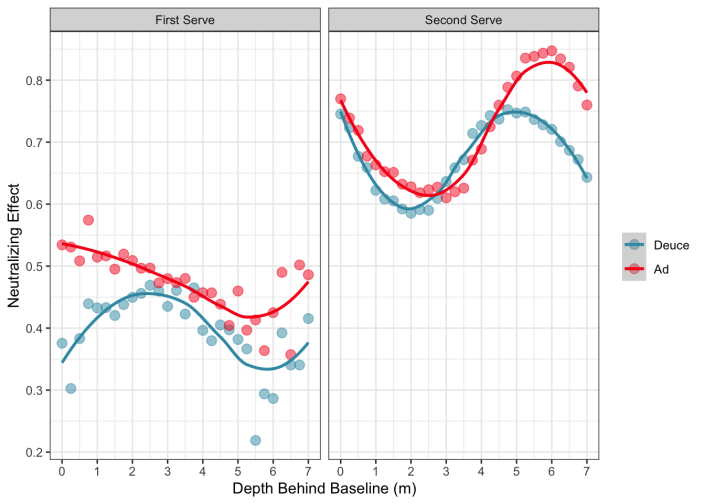Where should I stand to receive serve?
This week’s question comes from a mid level Badge player. Where should I stand to receive serve? If I stand too far back, I can be aced out wide particular on the forehand court. If I stand too close, I can get overpowered particularly on a big serve?
Pros employ various strategies to returning serve to neutralize the servers advantage. Medvedev/Djokovic/Nadal play a long way back, Federer/Kyrgios/Barty play closer to the baseline.
The following stats chart illustrates the variations in the “neutralizing effect of the serve” based on the returner’s position for either the forehand or backhand court and, for first and second serve. Note the huge difference in the Second Serve position where the server has lost the advantage of the first serve!

Ultimately, the best approach for you is the one that provides you with a long-term advantage in getting into the game and creating the opportunity to win more points. I teach this as your “Happy Position“.
To optimize your return position and neutralize the server’s advantage, here are a few guidelines to help you find your ‘happy position’:
- Assess the server’s tendencies: Observe the server’s patterns, strengths, and weaknesses. Do they often go for powerful serves or rely on placement? Are they consistent with their first serves? Flat, slice or kick second serve? This information will help you anticipate their shots and allow to adjust your position accordingly.
- Consider court positioning: For first serves, standing around 2 to 4 meters behind where the ball bounces in the service box is a good starting point. This allows you to have enough time to react to powerful serves while still being able to cover a wide serve on the forehand court. Standing deeper than 4 meters may make you more vulnerable to wide serves, so find a balance between depth and court coverage.
- Adapt to second serves: As the chart shows, second serves often offer greater opportunities for an aggressive return. Here, the optimal return positions are significantly different. Some players excel at taking the ball on the rise, while others prefer a position where the ball has dropped slightly. On average, attempting to take the ball on the rise is much more challenging for club players, so finding a comfortable position where you can consistently make solid contact is key. Experiment with different positions during practice sessions to determine what works best for you.
- Focus on the key third hit: Remember that the return is just the beginning of the point. Aim to hit a deep and well-placed return that puts pressure on the server. If you force a short ball on the server’s second hit (the third shot in the point), it opens up opportunities for you (or your partner) to attack with an easy volley or a strong groundstroke.
- Be Adaptability: Tennis is a dynamic sport, and your return position should adapt to various factors such as different opponents, court conditions, and serve styles. Stay flexible and be willing to adjust your positioning based on the specific circumstances of each match.
Find your own “happy position,” where you can consistently return the serve and get into the point. This is typically at waist height, while allowing you to move forward into the ball, and around 3 meters from where the serve bounces in the service court! And yes it changes from first to second serve, from opponent to opponent, from day to day as court conditions change!
Good luck,
Rob Tennis Whisperer


